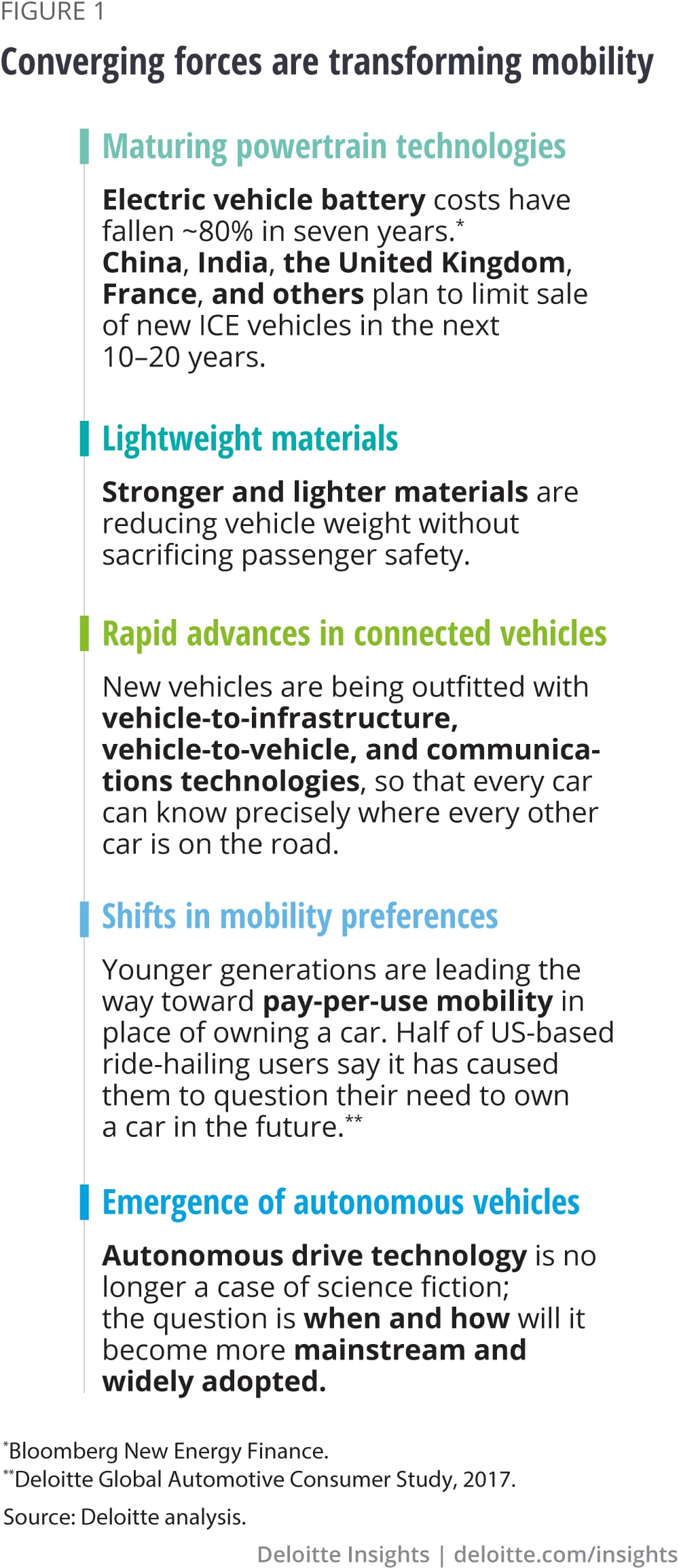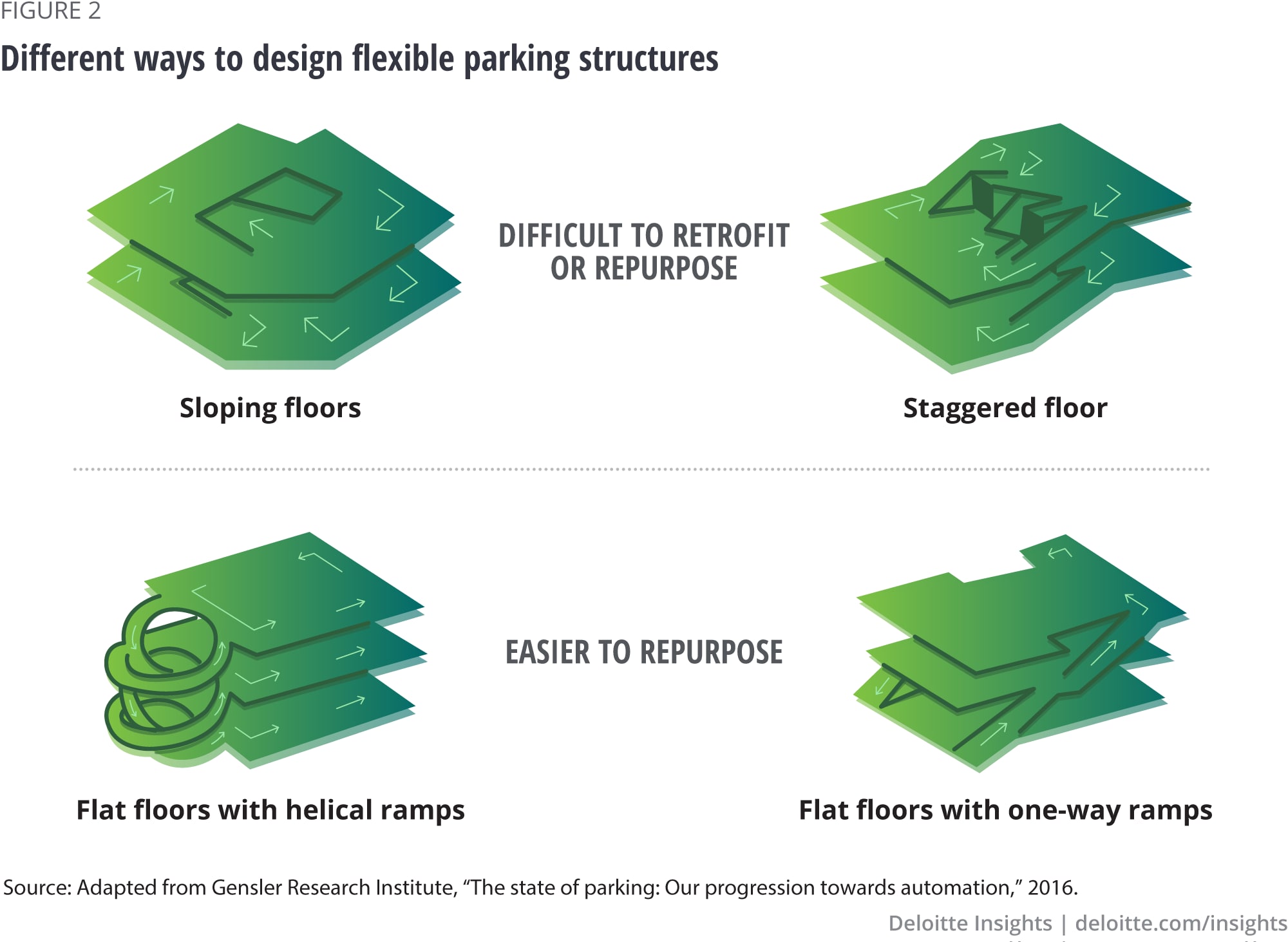
The future of parking Can providers find a space in the new mobility ecosystem?
02 November 2018
For drivers, the journey’s end may not always be so unpleasant: The future of mobility promises innovations that may ease the ordeal of parking. And for providers, there’s room enough in the parking space to thrive.
Introduction
For many drivers, parking is an unavoidably high-friction experience, whether it involves circling the block, hunting for an elusive curbside opening, or rushing to safely vacate your coveted space as an impatient fellow driver looms in your rearview mirror. It’s the price of getting into your car. As technology has made many of our daily activities increasingly seamless and convenient, from shopping to paying bills—even traveling from point A to point B, thanks to app-based ride-hailing services and real-time traffic updates—parking has stubbornly resisted, remaining among the worst elements of vehicle ownership.
But help may be just around the corner: The parking experience could be the next aspect of modern life to be upended by new technologies and business models. And it goes far beyond Internet of Things applications and more ubiquitous connectivity making parking more efficient and painless by increasing visibility—longer-term trends around shared mobility and the emergence of autonomous vehicles could dramatically change overall demand and the types and locations of parking infrastructure needed to accommodate cars and trucks. Some incumbent parking players as well as new technology entrants are already working to capitalize on these developments by creating new and innovative solutions to regulate demand, optimize supply, and better meet consumer needs.
In many cases, shifts in the world of parking will likely require walking a razor-thin line, as players across the mobility ecosystem seek to meet the demands of today’s customers and the current transportation environment while preparing for a future that could look significantly different as shared and ultimately autonomous vehicles become fixtures of the landscape.
Parking today
The US parking market is relatively stable and consolidated, generating roughly US$30 billion in gross parking revenue annually.1 A wide range of players are involved—most fundamentally, parking operators that plan and manage facilities while providing necessary staff and technology. Those facilities vary by location (on-street, off-street, off-street multilevel, corporate/university campus), fee type (timed, membership), and real estate type (owned, leased, management contract). Local governments own most public parking lots and facilities, occasionally granting control to parking operators, and often manage streetside parking.2
That relative market stability belies a number of persistent, underlying challenges. Lack of transparency, with respect to both availability and pricing, often creates consumer frustration and considerable economic costs. Americans on average spend 17 hours per year searching for parking, resulting in a cost of US$345 per driver in wasted time, fuel, and emissions.3 Those costs jump in major metropolitan areas: Drivers in New York spend 107 hours and US$2,243 annually. For local businesses, pricing policies and rates can negatively affect customer traffic.4 That leaves a delicate balancing act for many cities, as they seek to ensure sufficient parking to meet residents’ and visitors’ needs and foster economic growth, while avoiding unnecessarily tying up valuable real estate and encouraging more traffic than streets can handle.5 Many municipalities also rely on significant revenue from parking fees, raising the stakes further: The 25 largest US cities collected roughly US$1.5 billion total from parking in 2016.6
Finally, parking operators see a growing array of technological solutions, but the highest-profile are aimed at helping drivers find and pay for parking, with few holistically addressing operators’ business needs. While the airline and rental-car industries have found ways to use data to inform demand-planning algorithms, parking operators have not yet adopted standard solutions. They face an additional challenge in that their assets are generally immobile, limiting the ability to redistribute capacity. Complicating the situation is the frequent incompatibility between legacy infrastructure and newer solutions.
No-stopping zone: Technology-driven change comes to parking
Parking is inextricably linked to broader patterns of how people and goods move around—and those patterns are in the midst of transformative change. Driven by a series of converging forces (see figure 1), the entire way we get from point A to B is evolving.7 The result could be a new mobility ecosystem that provides faster, cheaper, cleaner, safer, and more efficient transportation than today.

Already, advances in vehicle connectivity, smart infrastructure, and IoT applications are changing the possibilities for parking. Sensor-equipped physical assets, such as garages and street meters, can offer operators real-time space availability and maintenance-needs updates, while feeding digital aggregator platforms with pricing data and license-plate recognition-based payment systems. For the consumer, such features can reduce search times and create a more seamless experience. For operators, it can enable more efficient use of assets and increase revenue by reducing the number of customers who give up and leave a lot, ramp, or neighborhood due to a perceived lack of space, while facilitating more dynamic and flexible pricing throughout the day or week.8 As cameras and other sensors become more cost-effective and data-processing capabilities grow, providers’ ability to react to changes in the environment is only likely to increase.
Even as technology available today offers significant opportunities, the intersection of ride-hailing and autonomous vehicles—along with new modes of transportation such as e-scooters and bikesharing—could fundamentally reshape the parking landscape in the coming years. The parking industry is predicated on widespread use of private, driver-driven automobiles, but Deloitte’s forecasts suggest that by 2040, more than half of the miles traveled in the United States could occur in shared autonomous vehicles,9 which would rarely need to park—at least not in the ways parking has traditionally occurred (idle throughout an entire workday, for example).
While the timing and impact of these trends is uncertain, many areas could see less general demand for parking. That’s likely to be especially true in dense urban areas that are or become well served by shared self-driving fleets, public transit, and other mobility options, enabling people to substitute away from personal vehicles. At the same time, the need for space to maintain those fleets could increase, along with demand for new types of spaces such as pick-up/drop-off zones and electric-vehicle charging stations.
More than space between yellow lines: Creating value in parking
As the future of mobility unfolds, the future of parking will likely be driven by those able to develop innovative solutions to manage demand, optimize supply, and better meet consumer needs with the support of digital technologies and processes. Success will depend in part on players’ ability to address the challenges of today while preparing for the changes that the industry will likely face in the future. In particular, new and important opportunities will likely materialize around:
Value-add services. Real estate companies and management firms that operate parking facilities could look to maximize their competitive advantage by adding services to existing parking space. That could include electric-vehicle charging stations, enhanced security features, automated parking that uses sensors and lifts to place cars optimally and improve retrieval times, and vehicle servicing and maintenance—all of which provide opportunities for facilities to differentiate themselves and charge a premium. Airports in Houston, Milwaukee, Pittsburgh, and elsewhere have implemented valet parking services in recent years as a way to increase revenue.10
Space management. Data analytics and telematics can enable a frictionless process that matches vehicles with parking spots, with utilization optimized based on supply and demand. Spanish company Urbiotica, for example, in 2016 implemented an automated parking solution for Audi’s factory in Ingolstadt, Germany, which houses more than 40,000 employees. Using sensors to detect vehicles entering and leaving each parking sector, the system calculates occupancy data and communicates real-time availability via digital displays, guiding drivers to free spaces and reducing congestion.11 Cities such as Jacksonville, Florida, have used street sensors to launch mobile apps enabling drivers to find available on-street parking spaces in real time, as well as the locations of parking garages and lots.12
Flexible facilities. With increased use of ridesharing and the coming availability of autonomous vehicles that might rarely need to park, lot operators may be able to convert existing facilities or design new ones in ways that enable multifunctional use or repurposing as a hedge against a future with less need for parking. The structural requirements of a parking garage (load-bearing needs, floor slopes, etc.) diverge in important ways from those needed for a retail or residential space, but some design firms are already planning for such convertibility (see figure 2).13 Ultimately, real estate developers and parking operators may need to make a difficult choice between spending more today or risking having an underutilized facility in the future.
Payments and pricing. Seamless payments (potentially integrated with other transportation costs such as public transit passes or tolling) and dynamic pricing can provide opportunities for both public and private operators. A pioneer in dynamic pricing, San Francisco launched a demand-responsive pricing program that manages public parking on a block-by-block, time-band by time-band basis.14 In December 2017, the city rolled out the program to all 28,000 parking spaces on public streets and 14 city-operated garages, using a real-time, algorithmic methodology to generate optimal parking rates. Many cities are also embracing well-tested mobile payment technology. For example, Philadelphia’s meterUP app enables mobile payment at all kiosks and meters in the city, allowing drivers to remotely add time to their parking sessions, abort a session early to avoid wasting unused minutes, and prepay for parking.15 Such data could potentially be monetized: Local merchants, for instance, could be interested in leveraging it for planning purposes or to push offers to nearby customers.

Building capabilities for today and tomorrow
In the near term, providers have an opportunity to significantly improve the customer experience while simultaneously gaining a more holistic, accurate, and real-time picture of how facilities are being used, potentially enabling smarter use of space. Over the horizon, as many of the longstanding tenets of American transportation are likely to come into question in the face of new technologies and new services, the parking landscape looks to become increasingly unsettled. In the face of those challenges, players should look to build the capabilities needed to succeed today, while keeping an eye firmly fixed on how mobility is evolving in the markets they serve. In particular, parking operators—whether public or private—should pay particular attention to:
Customer experience. Today, many parking managers and government agencies receive feedback by tracking historical data. As data becomes more readily available for space owners and drivers alike, developing a more user-friendly customer experience is increasingly possible—and likely to be ever more necessary, as consumers bring heightened expectations from smoother e-commerce and other interactions.
Technology and data analytics. Data analytics and a modern IT infrastructure to ensure real-time tracking and end-to-end visibility are likely to increasingly be foundational competencies in the parking space. Players should also look broadly across the landscape of available technology capabilities to things such as mobile payments, telematics, crowdsourcing, IoT applications, and blockchain for ways to add value and improve operations.
Location management. Location is, of course, critical in parking, and effectively selecting and managing sites is important for predicting and planning for customer behavior and traffic patterns. Rather than creating customized parking plans for each location, providers establishing repeatable processes and working with relevant government agencies to create flexible regulatory requirements as parking demands change will help reduce planning costs. Providers should also seek to anticipate how land usage could change in the future to minimize the risks of being saddled with underutilized or unneeded facilities.
Efficient pricing systems and demand management. For companies in the private parking industry, competitive pricing is important in areas where parking services are widely available. For governments, efficient pricing is necessary to strike a balance between encouraging drivers to visit key business areas and avoiding congestion and long search times. Visibility into parking utilization and traffic can enable dynamic pricing systems that better match supply and demand.
Strong partnerships. Industry operators that compete for management contracts at public and private properties should develop strong relationships with various partners to ensure their operations’ longevity and create a differentiated and more-valuable service. Providers could partner with automotive OEMs to plan together for new vehicular parking needs, with technology companies to create new solutions to improve the customer experience, with finance and payment companies to develop novel ways to collect revenue from parking, or even with local pop-up businesses to manage variability in parking demands. Government agencies might need to collaborate with each other to effectively coordinate policies across jurisdictions and domains—for example, the parking authority working with economic development agencies or the local parks department.
Robust cost management. Parking is an asset-heavy industry due to the cost of real estate and infrastructure: One study estimated the median cost per space when building a new structure at roughly US$20,000.16 However, efficient management of resources and streamlining of processes through technologies such as robotics and automation could help recoup upfront asset costs faster than traditional methods. This could include digitizing and automating contracts, tracking usage to redistribute risk and cost, or even creating a platform to invite new investors.
Conclusion
To the uninitiated, parking may seem like a staid industry immune to the dramatic technology-driven changes that have swept so many corners of the economy. But even in an industry that is, at its core, about physical space, digital technologies present a host of opportunities and challenges. Today, there is a significant opening to apply technologies to create a more user-friendly, efficient, and valuable parking experience.
Changes to parking options—and realizing gains—will not happen overnight, and moving to a smart parking environment will take coordination and cooperation among a variety of players: operators, governments, payments providers, technology companies, and more. For those willing to not only look at today’s needs but anticipate tomorrow’s challenges, they may find that parking can be an important enabler—rather than a victim—of the future of mobility.
© 2021. See Terms of Use for more information.







